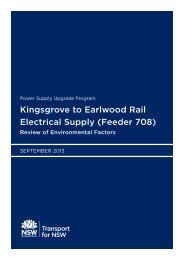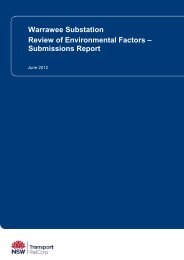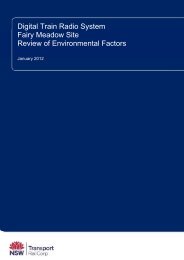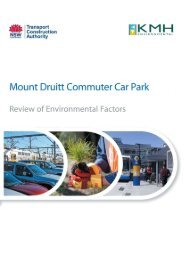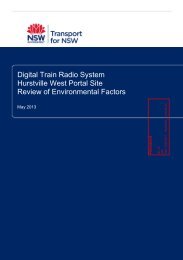Warrawee Substation - Review of Environmental Factors
Warrawee Substation - Review of Environmental Factors
Warrawee Substation - Review of Environmental Factors
- No tags were found...
You also want an ePaper? Increase the reach of your titles
YUMPU automatically turns print PDFs into web optimized ePapers that Google loves.
Scientific Name Common Name TSC/FMActEPBC Act Habitat Association Nature <strong>of</strong> Record Likelihood <strong>of</strong>occurrenceacacia woodlands and riparian woodlands <strong>of</strong> interiorNSW are also used. For nest sites it requires a tallliving tree within a remnant patch, where pairs build alarge stick nest in winter and lay in early spring.Potential for impactsGlossopsitta pusilla Little Lorikeet V - Occurs from coast to western slopes <strong>of</strong> the GreatDividing Range. Inhabits dry, open eucalypt forestsand woodlands. Feed primarily on pr<strong>of</strong>usely-floweringeucalypts and a variety <strong>of</strong> other species includingmelaleucas and mistletoes. On the western slopesand tablelands Eucalyptus albens and E. melliodoraare particularly important food sources for pollen andnectar respectively. Mostly nests in small (openingapprox. 3cm) hollows in living, smooth-barkedeucalypts, especially Eucalyptus viminalis, E. blakelyiand E. dealbata.Tyto novaehollandiae Masked Owl V - Occurs across NSW except NW corner. Mostcommon on the coast. Inhabits dry eucalyptwoodlands from sea level to 1100 m. Roosts andbreeds in large (>40cm) hollows and sometime cavesin moist eucalypt forested gullies. Hunts along theedges <strong>of</strong> forests and roadsides. Home range between500 ha and 1000 ha. Prey mostly terrestrial mammalsbut arboreal species may also be taken.9 records within10km (OEH2012a)7 records within10km (OEH2012a)Unlikely.No suitable habitat.Unlikely.No suitable habitat.Nil.Nil.Rostratula benghalensis Painted Snipe (wasAustralian PaintedSnipe)E V, M Normally found in permanent or ephemeral shallowinland wetlands, either freshwater or brackish. Nestson the ground amongst tall reed-like vegetation nearwater. Feeds on mudflats and the water's edgePredicted to occurwithin 10km(DSEWPaC 2012a)Unlikely.No suitable habitat.Nil.



